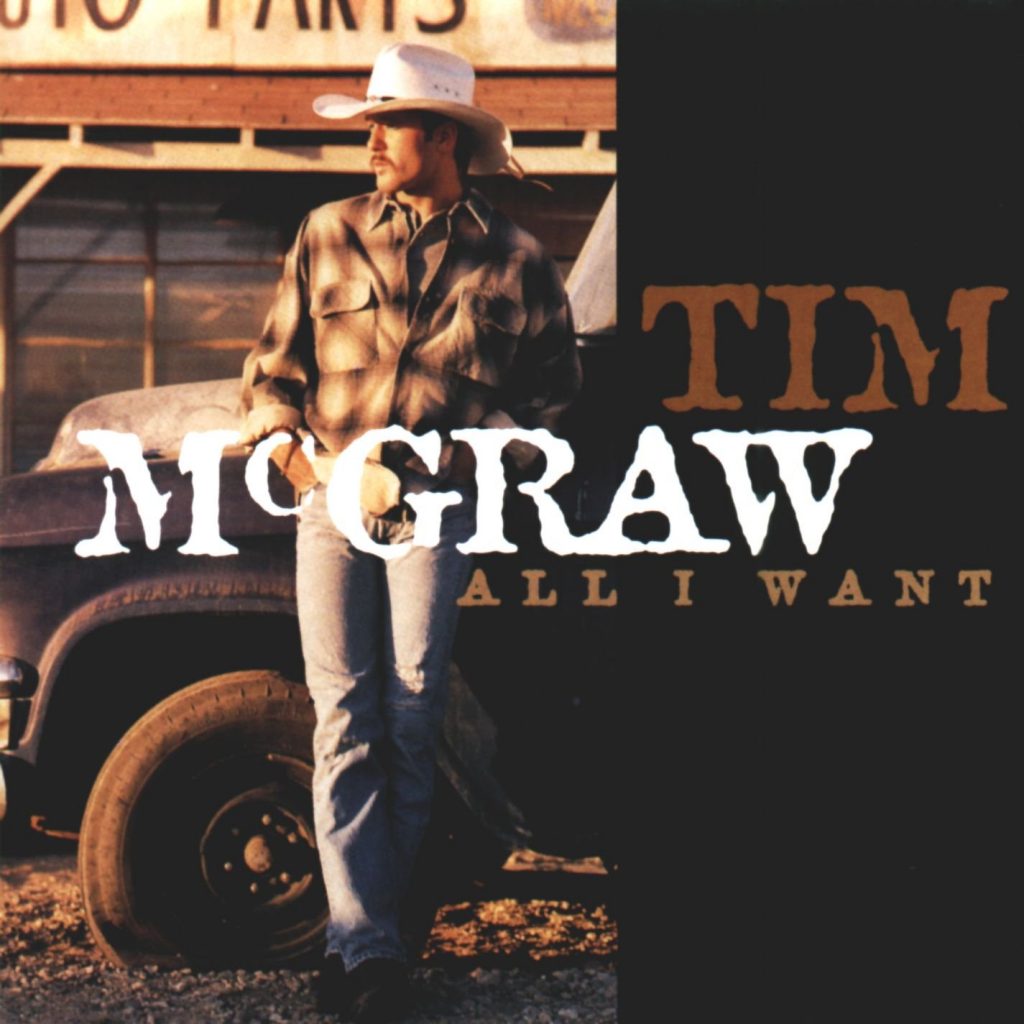25 Years Later: Tim McGraw’s ‘All I Want’
Tim's record spawned five smash singles.

Tim McGraw’s 1994 sophomore album, Not a Moment Too Soon, sent out unwavering signals that a new star was lurking over the horizon. Not a Moment Too Soon yielded McGraw’s first No. 1 single, “Don’t Take the Girl,” along with other hits like “Indian Outlaw” and the album’s title track. The overall stats for the record were duly striking: 29 weeks at No. 1, longer than any other album release that year, and three million sales by the end of the year, making it the top-seller of 1994.
McGraw wasted little time following up, releasing his third career album, All I Want, on September 19th, 1995. And while it didn’t quite match the impressive numbers of its predecessor, All I Want proved that the rugged singer from Louisiana was no mere flash in the pan. The album spent three weeks at the top, upending Shania Twain’s The Woman In Me. It was also certified for two million sales at the end of 1995, and spawned five Top 5 singles, including two No. 1s, “I Like It, I Love It” and “She Never Lets It Go to Her Heart.”

On the 25th anniversary of its release, we take a look back at the top tracks from All I Want and dive into its legacy.
Challenging Material
McGraw received critical praise for All I Want, mainly for the ease in which he tackled a variety of themes and more challenging territory. He handled heartbreak in “Can’t Be Really Gone,” one of the singles from the record, and the track, “Don’t Mention Memphis.” Cuts like “She Never Lets It Go to Her Heart” and “Maybe We Should Just Sleep On It” revealed a tender side, while “I Like It, I Love It” was little more than a rousing good time but done up right with a hearty dose of Southern-fried gusto.
In the All Music Guide to Country, critic Stephen Thomas Erlewine, reviewing All I Want, wrote that, “[McGraw’s] ballads are delivered with convincing sincerity.” That was certainly evident in “Can’t Be Really Gone,” where McGraw makes you feel the ache without overdoing the emotion, and in another of the album’s cuts, “I Didn’t Ask and She Didn’t Say.” The latter tune about running into an old lover was not released as a single, but the potential was nonetheless there. McGraw showed a facility for communicating a story/song, employing a nice conversational style.
Apparently, McGraw was attracted to songs that were dotted with just enough ambiguous overtones to make them interesting – and keep listeners guessing. “Can’t Be Really Gone,” released in October of 1995, was deliberately penned to be open to interpretation, according to the song’s sole writer, Gary Burr. In a YouTube interview for the book, Chicken Soup for the Soul: Country Music, Burr revealed that the scenario was inspired by a true-life incident. But he added, “You never know, in my song, whether [the girl] is just gone, or dead, or what. And I liked that ambiguity.” Apparently, his publisher didn’t share Burr’s enthusiasm. “It sat in a closet for seven years because my publisher kept telling me it wasn’t finished,” Burr said. “Nobody wins, there’s no happy ending. It’s ambiguous.” But after several attempts at writing extra verses and a more distinct outcome, Burr decided to keep “Can’t Be Really Gone” in its original form. McGraw heard the song – to this day, Burr isn’t quite sure how – and told Burr that he wanted to cut it. “He did a great job,” Burr raved. Fans obviously agreed, as “Can’t Be Really Gone” peaked at the No. 2 spot.
On a less esoteric note, the high-spirited “I Like It, I Love It” contains its own ambiguous touch. We don’t exactly know (though we can surmise) what “It” refers to – sex, the relationship itself, perhaps just an overall warm-and-fuzzy feeling. Whatever “It” was, McGraw slyly assured that he wanted “some more of it,” and basically left it up to the listeners to draw their own conclusions. The breezy tune was the first single released from All I Want and cruised all the way to No. 1, becoming McGraw’s third career chart-topper.
McGraw drew from a well-stocked array of writers for All I Want, including Burr along with stalwarts like Tom Shapiro and Chris Waters (“She Never Lets It Go to Her Heart”), and BlackHawk’s Van Stephenson (“I Didn’t Ask and She Didn’t Say”). Brett Beavers, best known these days for his work with Dierks Bentley, picked up one of his earliest songwriting cuts with “The Great Divide.”
The Legacy
With All I Want, McGraw solidified his standing as a future superstar, building upon the breakout success of Not a Moment Too Soon. Sparked by the popularity of those albums, McGraw turned into a major concert attraction, headlining The Spontaneous Combustion Tour in 1996 with future wife Faith Hill as his supporting act. The tour became the year’s top-selling road show.
In his review of All I Want for All Music Guide to Country, Erlewine praised McGraw’s all-around artistic improvement, noting that, “[McGraw] has grown musically and developed into a thoroughly entertaining vocalist.” McGraw has continued to soar ever since.


